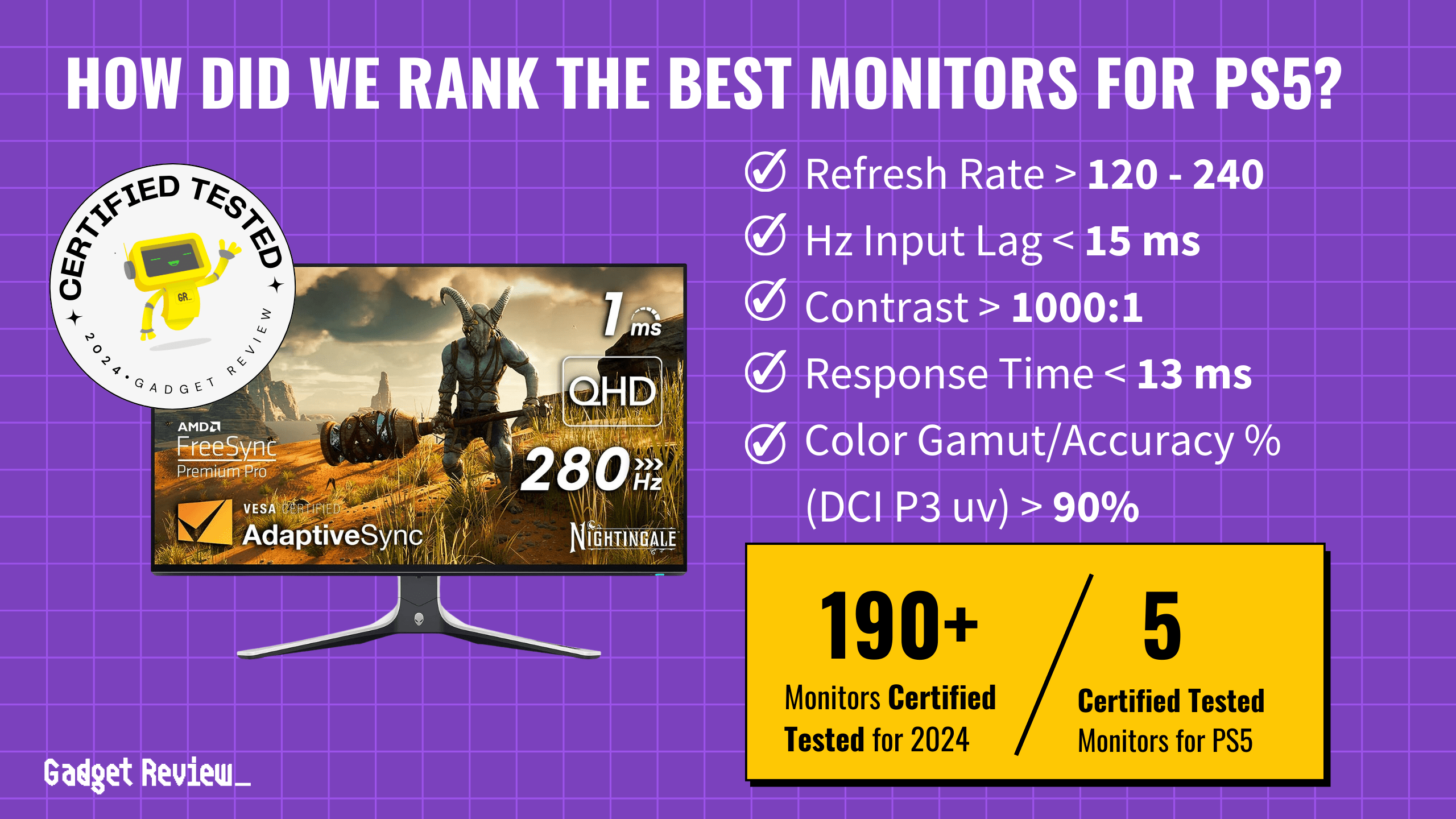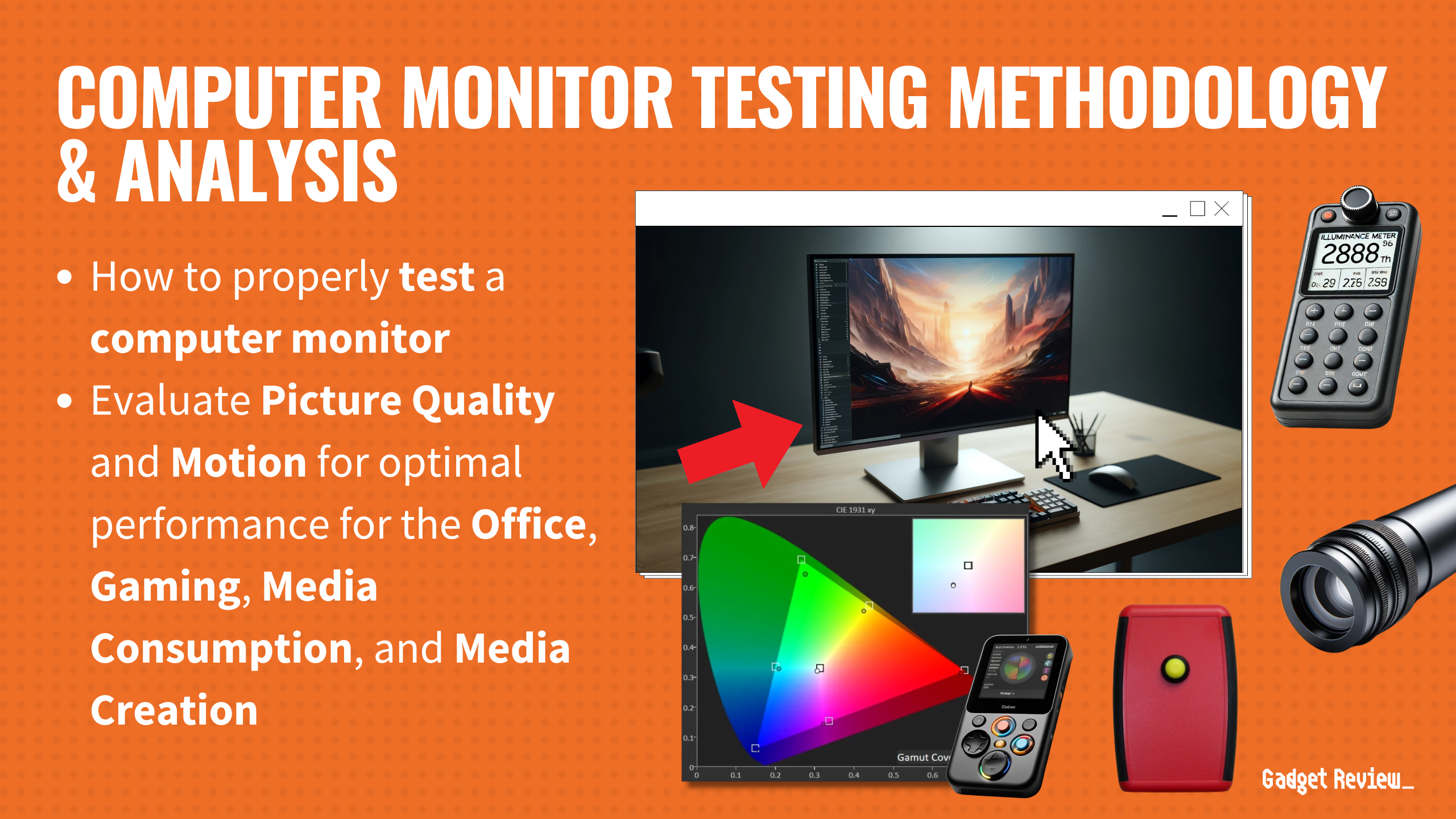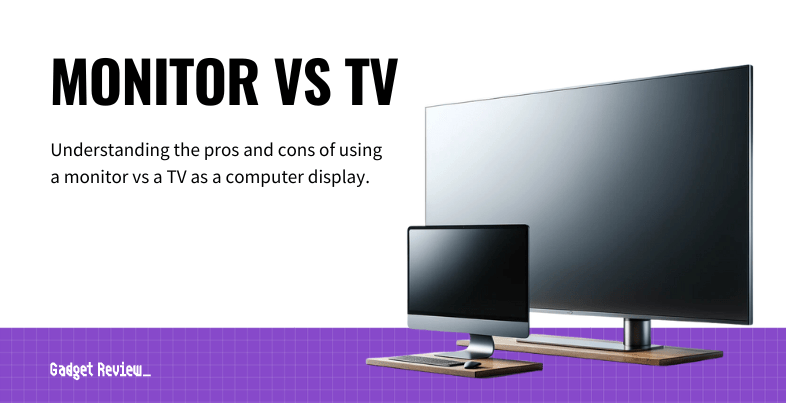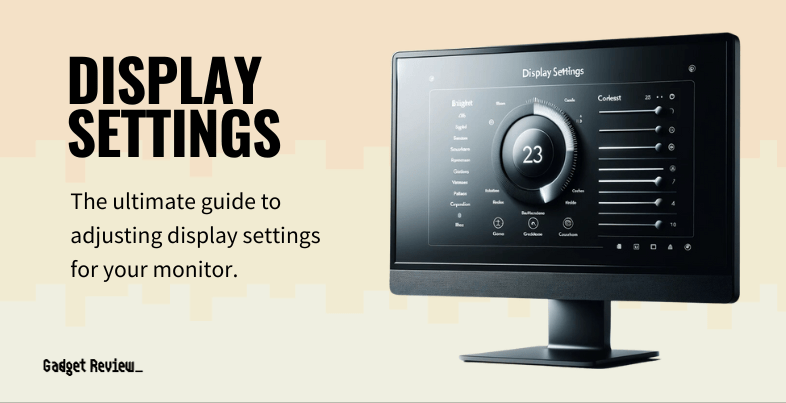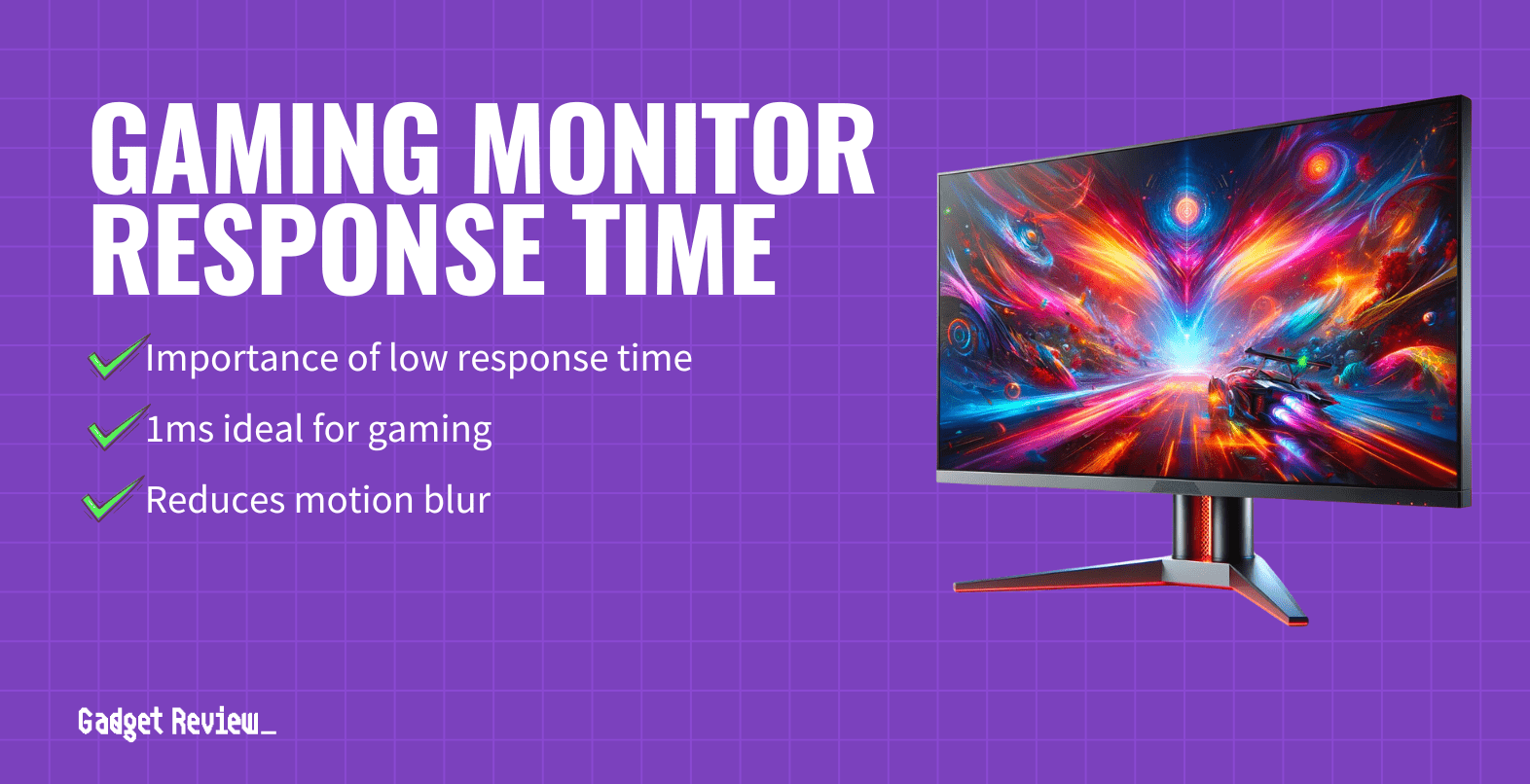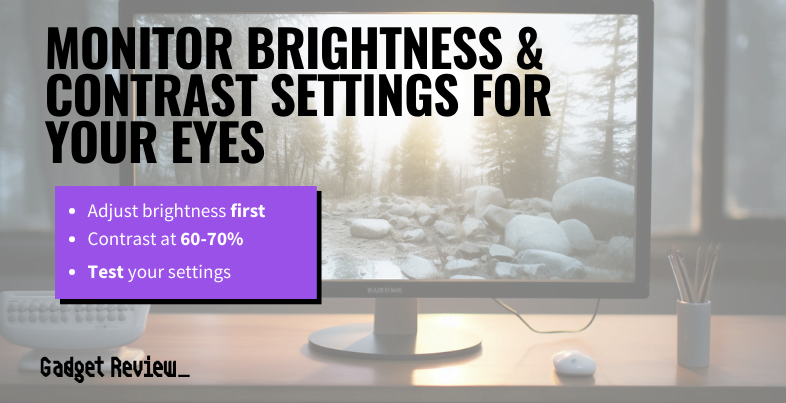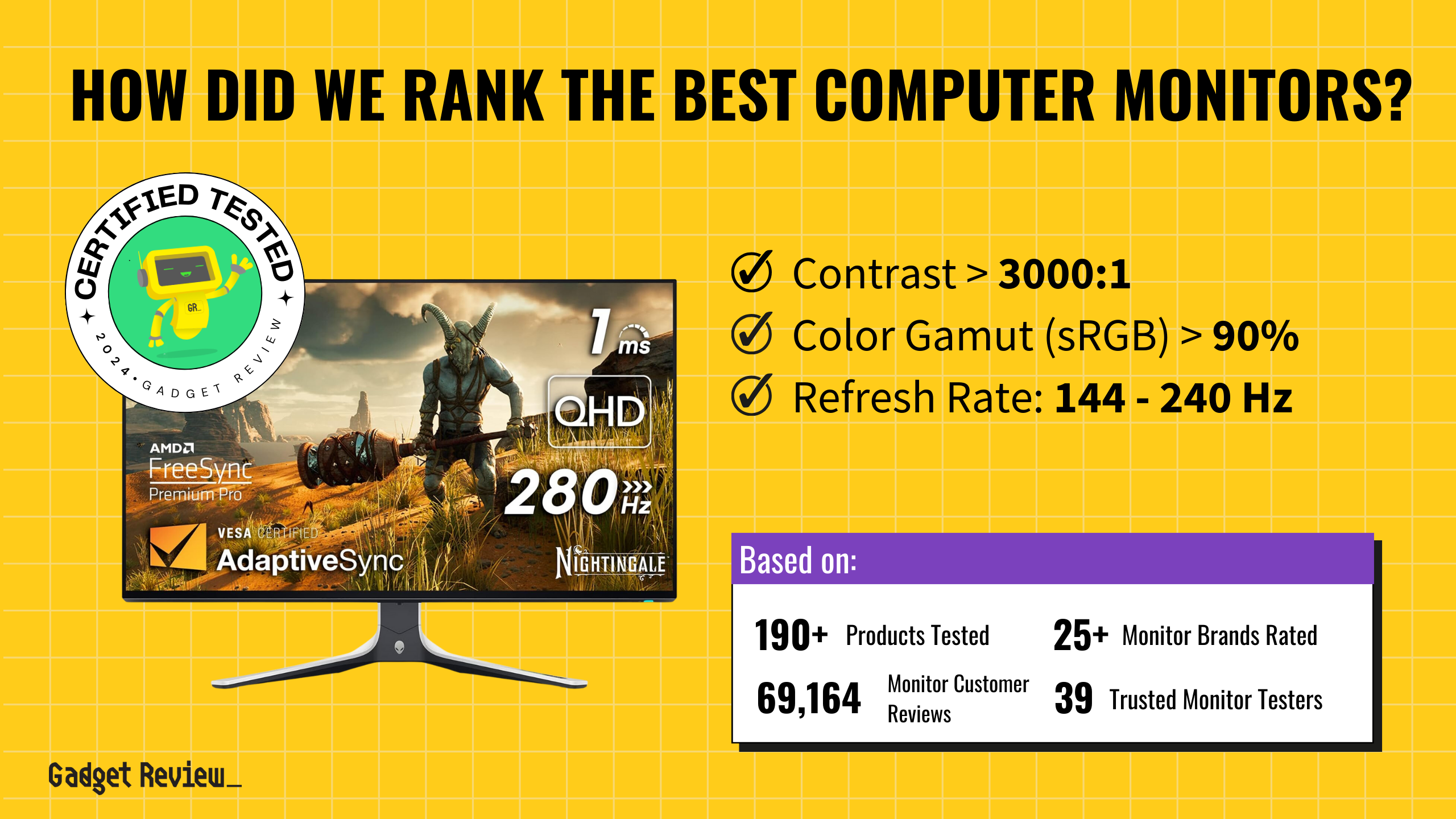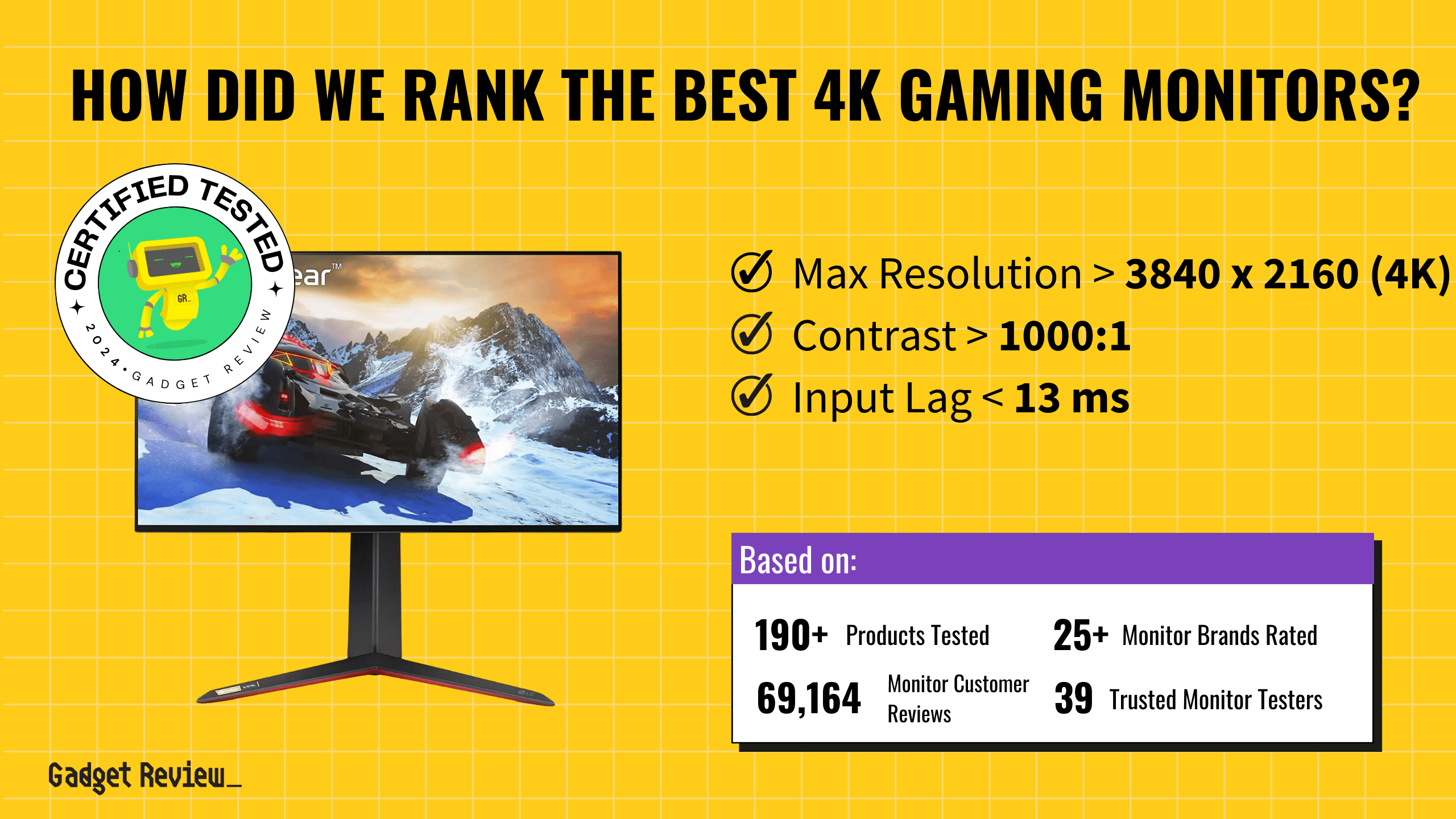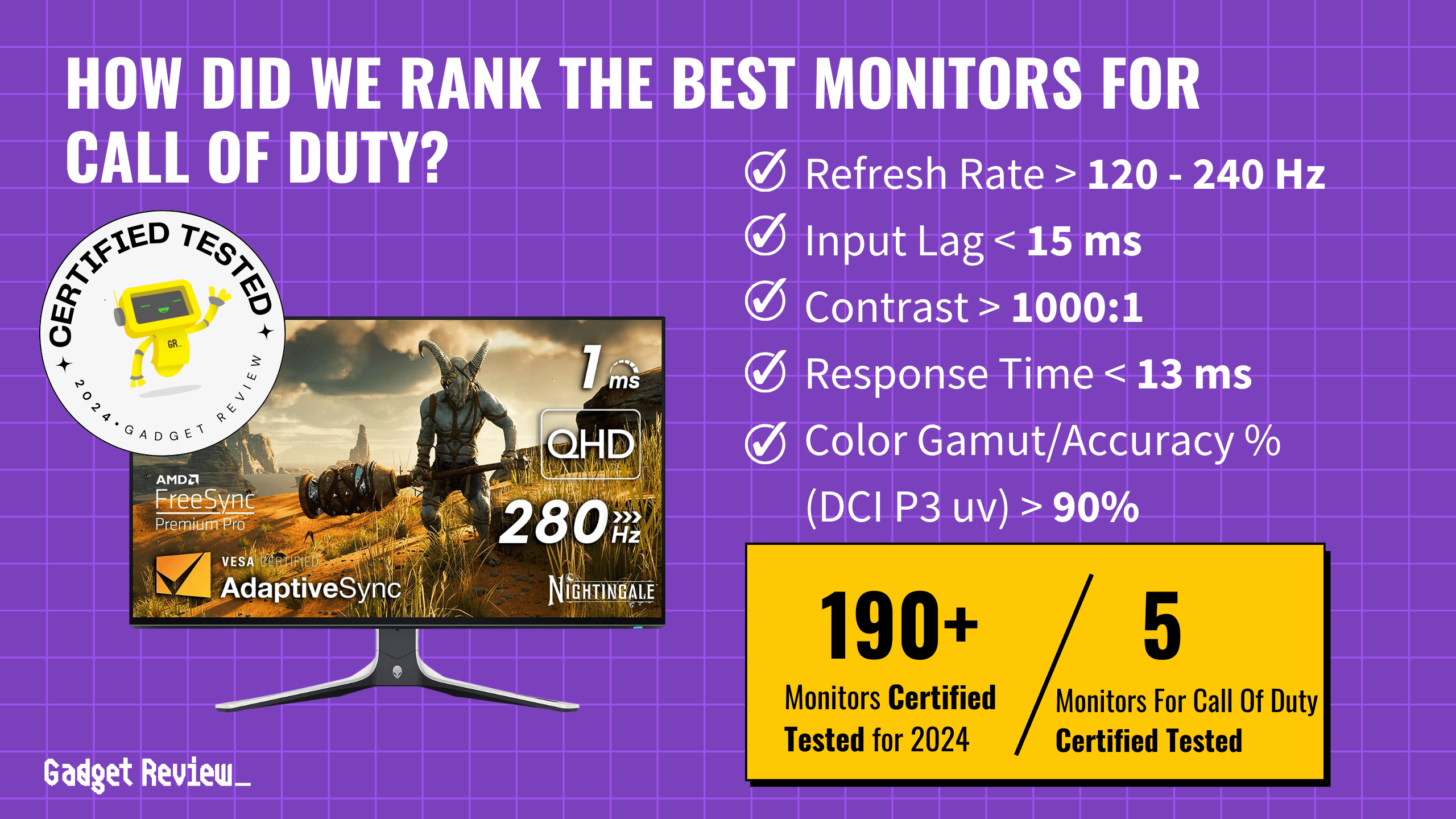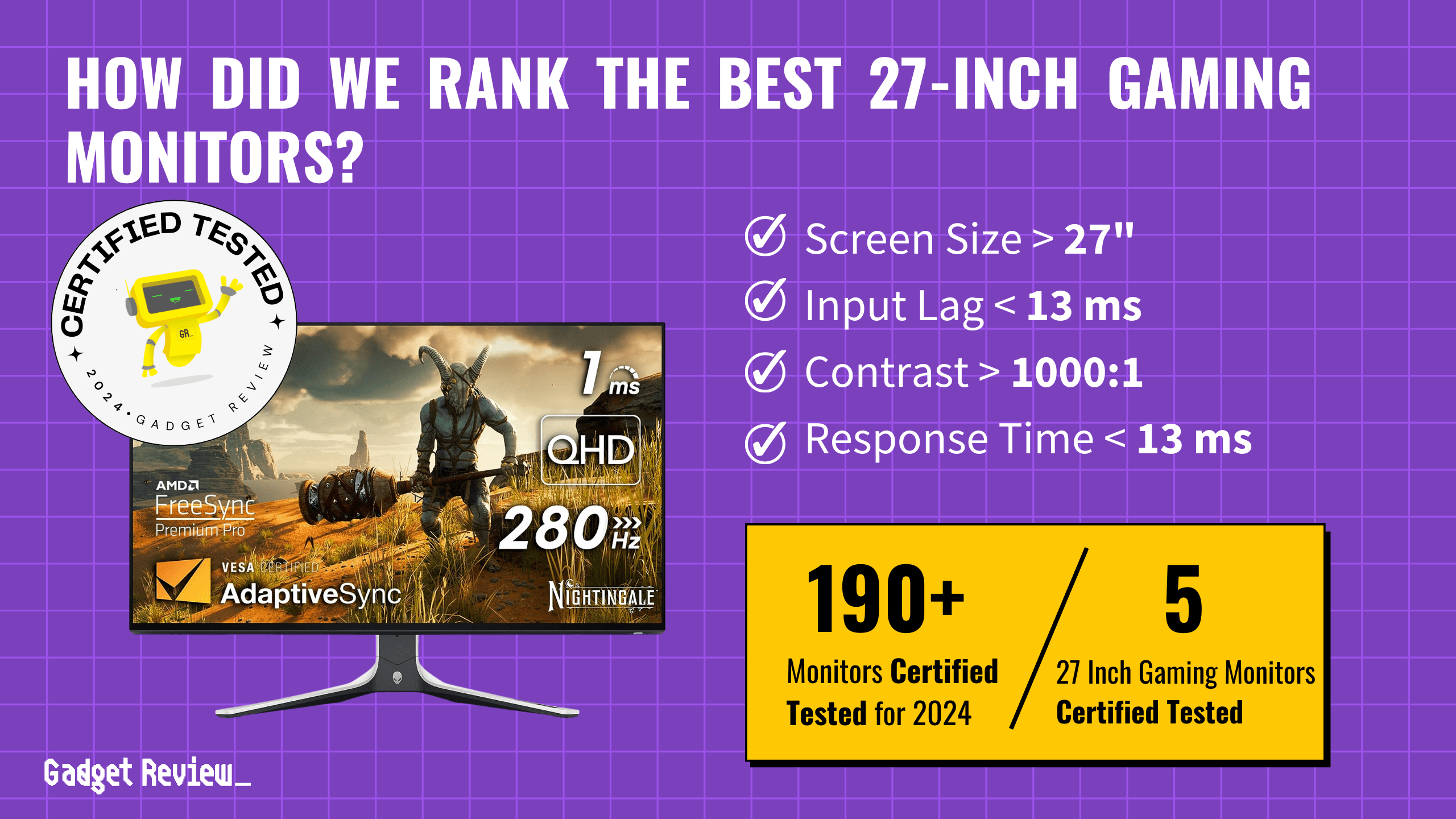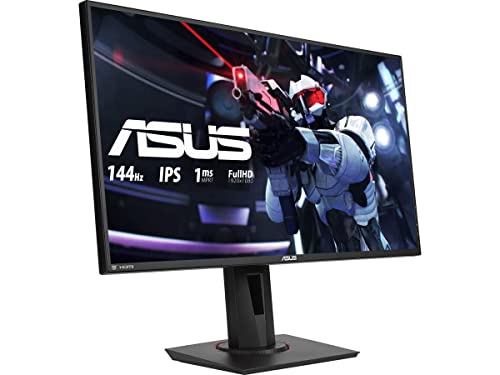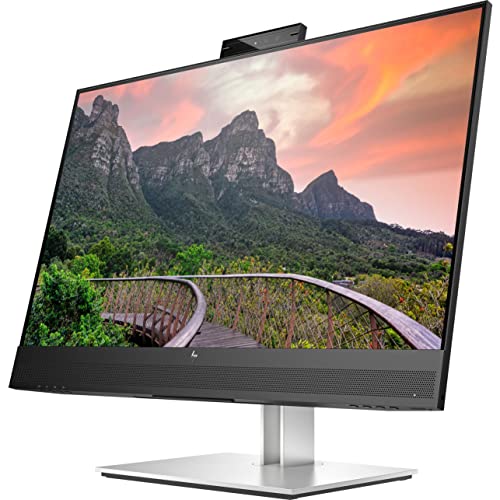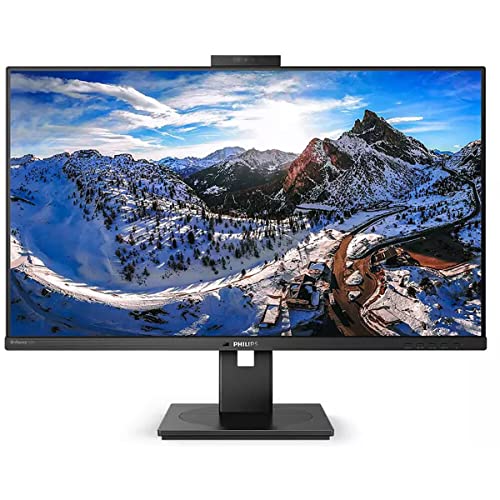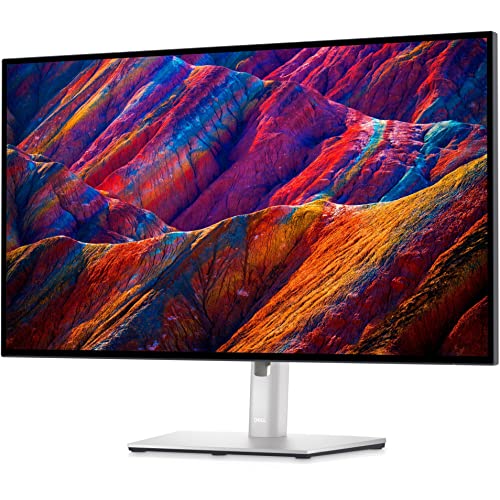When choosing the best monitor for your PS5, you’ll want features that fully utilize the console’s capabilities. Look for a refresh rate greater than 120Hz for smooth gameplay, input lag less than 15ms for quick response times, and a contrast ratio above 1000:1 for depth and detail. Ensure the monitor has good brightness for visibility in various lighting and wide color gamut coverage for vibrant colors. A low response time is key to reducing motion blur for a clear gaming experience.
In our buying guide, we analyzed 196 monitors, identifying five top performers. We examined 319,965 reviews, certifying the monitors as tested and filtering out fake and low quality reviews. Our analysis revealed 71% of experts were untrustworthy. Our rigorous approach uses a True Score and Trust Score to ensure accuracy. The winning monitors excelled in performance, providing exceptional gaming experiences.
The best gaming monitors are designed to enhance your gaming experience with superb refresh rates and crisp visuals. These monitors are considered top-tier monitors, combining outstanding performance with advanced gaming features.
Here are the top 5 monitors for PS5 from $599-$999 for any budget and use.
How Did We Rank the Best Monitors for PS5?
To provide the ultimate buying guide for PS5 monitors, we analyzed more than 200 websites, diving deep into testing methods and customer reviews. We identified 2 key test results, 2 nice-to-have features, and 1 must-have specifications, distilling what matters most for gamers. By integrating expert reviews with our true score system, we ensure our recommendations are both accurate and trustworthy, giving you confidence in your purchase.
Our commitment to unbiased reviews is powered by our ‘True Score’ system, targeting low quality and fake reviews. When you shop through our links, you’re backing our mission. Dive deeper to see how.
?️ Minimum Specifications
- Must have refresh rate of more than 120 Hz.
? Test Criteria
- Input Lag: An input lag of less than 15 milliseconds ensures a highly responsive gaming experience with minimal delay between action and on-screen response.
- Contrast Ratio: 1000:1 or higher (infinite), offering deep blacks and bright whites for an exceptional viewing experience.
? “Nice To Haves”
- Color Accuracy: At least 90% of the DCI P3 color gamut, providing rich and vibrant colors.
- Fast Response Time: 10ms or less, ensuring smooth transitions without motion blur.
Latest Updates
- 05/06/2024: Republished the list to include the best monitors for PS5 based on our True Score system.
Top Monitors for PS5 For 2025
Prices accurate at the time of publishing

Best Overall

Runner Up

Best Value

Best Budget

Best Mid-Range

Premium Pick
Asus ROG PG27AQDM
Best For Nintendo Switch
The Asus ROG PG27AQDM delivers blur-free, responsive PS5 gaming at a premium. Its OLED panel ensures vibrant colors and deep contrasts, justifying its high cost for enthusiasts.
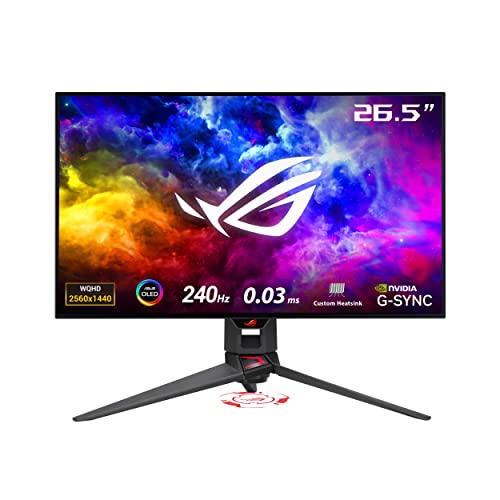
True Score
878910Experts
906kCustomers
Absolutely Fresh
 $741.00
$741.00Snapshot
Reasons to Buy
- Stellar Picture Quality
- Fast Response Time
- Low Input Lag
- High Refresh Rate and VRR Support
- Wide Viewing Angles
Reasons to Avoid
- No HDMI 2.1 Support
- Low Overall Brightness
Specifications

Aspect Ratio 16:9 
Available Inputs 3.5mm, DisplayPort, HDMI, USB 
Bluelight Filter Yes 
Built-In Speakers Yes 
Built-In Webcam No 
Curved Screen No Display Type LED 
Flicker Free Yes HDMI Inputs 2 HDR Format HDR10 High Dynamic Range (HDR) Yes Max Resolution 2560 x 1440 
Panel Type OLED Refresh Rate 240 Hz 
Response Time 0.03 ms 
Rotating Screen Yes Screen size 26.5″ 
Sync Technology AMD FreeSync, G-Sync All Specs
Test Results
Brightness (nits) 311 Contrast Ratio (as ratio, x:1) 0 Color Gamut/Accuracy % (DCI P3 xy) 95 Color Gamut/Accuracy % (DCI P3 uv) 0 Color Gamut % (Adobe RGB Coverage xy) 90 Color Gamut % (sRGB Coverage xy) 100 All Retailers
- $741.00
Availability
In StockFree Shipping
No - $749.00
Availability
In StockFree Shipping
Yes
Our Verdict
If you’ve been looking for a high-end monitor for your PS5, the Asus ROG PG27AQDM offers superior performance that eliminates ghosting and blur, but it’s got a premium price to match. It features a low input lag of 10.8 ms—which decreases further at maximum refresh rate—and a swift 2.1 ms response time, allowing for ultra-responsive gameplay. This monitor is equipped with G-Sync and FreeSync, ensuring seamless, tear-free gaming alongside a 240 Hz refresh rate for smoother motion.
With a brightness level of 311.2 nits, it performs well across various lighting conditions, except in very bright rooms. Its exceptionally low 2% reflectivity significantly reduces glare. The OLED panel provides outstanding contrast and vivid color with 99.98% sRGB coverage, enhancing the visual richness of games with accurate colors. If you’re often marathon gaming, the flicker-free panel and blue light filter are designed to minimize eye strain.
Price is the biggest sticking point for the PG27. However, despite being one of the most premium options on our list, its OLED panel, exceptional contrast and color quality, and excellent responsiveness more than make up for the high asking price. If you don’t need to see the price tag, it’s hard to argue with Asus’ PG27QDM.

Best Overall

Runner Up

Best Value

Best Budget

Best Mid-Range

Premium Pick
HP OMEN 27QS
The HP OMEN 27QS is budget-friendly without sacrificing quality. It offers low input lag, high refresh rates, and vibrant colors for an unbeatable PS5 gaming experience.
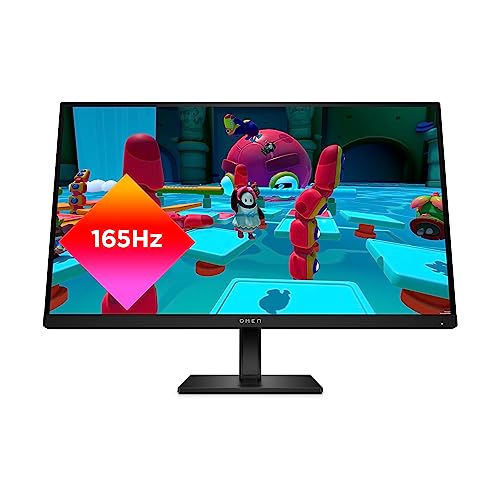
True Score
85834Experts
911kCustomers
Absolutely Fresh
 SAVE $100$299.99$199.99
SAVE $100$299.99$199.99Snapshot
Reasons to Buy
- Good Image quality
- Low response time
- Low input lag
- High refresh rate
Reasons to Avoid
- Low contrast ratio
Specifications

Aspect Ratio 16:9 
Available Inputs 3.5mm, DisplayPort, HDMI, USB 
Bluelight Filter Yes 
Built-In Speakers Yes 
Built-In Webcam No 
Curved Screen No Display Type LED 
Flicker Free Yes HDMI Inputs 2 HDR Format HDR10, HDR400 High Dynamic Range (HDR) Yes Max Resolution 2560 x 1440 
Panel Type IPS Refresh Rate 240 Hz 
Response Time 1 ms 
Rotating Screen Yes Screen size 27″ 
Sync Technology AMD FreeSync Premium, G-Sync All Specs
Test Results
Brightness (nits) 390 Contrast Ratio (as ratio, x:1) 1,014 Color Gamut/Accuracy % (DCI P3 xy) 94 Color Gamut/Accuracy % (DCI P3 uv) 0 Color Gamut % (Adobe RGB Coverage xy) 86 Color Gamut % (sRGB Coverage xy) 100 All Retailers
- $199.99$300Save $100
Availability
In StockFree Shipping
Yes - $429.00
Availability
In StockFree Shipping
No - $479.99
Availability
In StockFree Shipping
Yes
Our Verdict
If you’re on a budget, the HP OMEN 27QS is a surprisingly well-performing PS5 gaming monitor despite the much more affordable pricing. It has an excellent 8.5 ms input lag and a great 4.2 ms response time, it ensures swift and responsive gameplay critical for competitive gaming. Its 144 Hz refresh rate also helps smooth out content and reduce tearing, which is further enhanced by both FreeSync and G-Sync compatibility to eliminate tearing issues.
With a peak brightness of 389.5 nits, the 27QS is suitable for use in most lighting conditions outside of very bright rooms. Its 94.4% DCI P3 and 100% sRGB color coverage offer vibrant HDR and SDR visuals with precision, perfect for both standard gaming and movie watching. A blue light filter and flicker-free technology also help reduce eye strain when playing games for long periods of time.
Beyond gaming, the 27QS proves versatile for other entertainment needs, whether you’re watching movies, streaming, or using it for productivity tasks with a laptop connected.
HP’s OMEN 27QS offers an unbeatable combination of price and performance for PS5 gamers. With quick response times, high refresh rates, excellent input lag, and superior color quality, it’s an outstanding monitor that supports gaming and multimedia activities without straining your wallet.

Best Overall

Runner Up

Best Value

Best Budget

Best Mid-Range

Premium Pick
Corsair Xeneon 27QHD240
The Corsair Xeneon 27QHD240 leads with the fastest response time, perfect for competitive PS5 gaming. Despite its price, its OLED quality and adaptive sync support make it a top gaming choice.
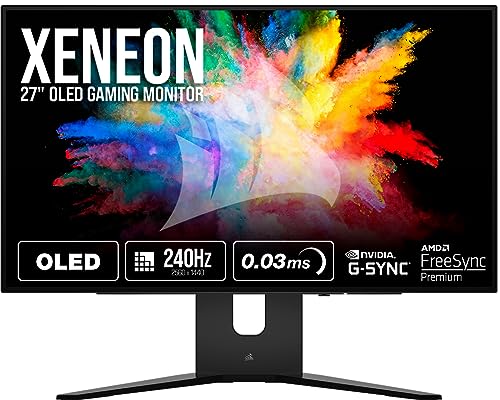
True Score
848310Experts
90336Customers
Absolutely Fresh
 $999.99
$999.99Snapshot
Reasons to Buy
- Excellent OLED Picture Quality
- Ultra-Fast Response Time
- Low Input Lag
- High Refresh Rate and VRR Support
Reasons to Avoid
- Lower Peak Brightness Levels
- Higher Input Lag with Different Refresh Rates
- Potential OLED Burn-In
Specifications

Available Inputs 3.5mm, DisplayPort, HDMI, USB 
Bluelight Filter Yes 
Built-In Speakers No 
Built-In Webcam No 
Curved Screen No Display Type OLED 
Flicker Free Yes HDMI Inputs 2 HDR Format HDR10 High Dynamic Range (HDR) Yes Max Resolution 2560 x 1440 
Panel Type OLED Refresh Rate 240 Hz 
Response Time 0.03 ms 
Rotating Screen Yes Screen size 27″ 
Sync Technology AMD FreeSync, G-Sync All Specs
Test Results
Brightness (nits) 318 Contrast Ratio (as ratio, x:1) 9,473 Color Gamut/Accuracy % (DCI P3 xy) 96 Color Gamut/Accuracy % (DCI P3 uv) 0 Color Gamut % (Adobe RGB Coverage xy) 90 Color Gamut % (sRGB Coverage xy) 107 All Retailers
- $999.99
Availability
In StockFree Shipping
Yes - $999.99
Availability
Free Shipping
Yes - $1,103.65
Availability
In StockFree Shipping
No
Our Verdict
The Corsair Xeneon 27QHD240 does one thing better than anything else: response time. If you’re looking for the absolute minimum possible response time for your PS5, 0.8 ms is the best option. While the 13.6 ms input lag is rather high for a gaming monitor, it drops significantly as you increase the refresh rate, dropping to a much lower time when you hit 240 Hz. The Xeneon also features G-Sync and FreeSync if you’re interested in using this monitor for your PC and PS5.
The monitor’s OLED panel slightly limits brightness to 317.5 nits, but that’s still plenty for most lighting that isn’t overly bright. The 96.1% DCI P3 and 106.96% sRGB color coverage are exceptional, offering vibrant and accurate colors for HDR content. The excellent sRGB range offers rich gaming, web browsing, and video content. The blue light filter and flicker-free display also help mitigate eye strain during extended gaming sessions.
The Corsair Xeneon 27QHD240 is tough to beat on response times, and its superb refresh rates and color fidelity make it all the more attractive. Sure, most OLEDs are expensive, but the panel’s deep contrast, wide viewing angles, and rich color performance make it an outstanding gaming monitor. If you’ve got the money for the monitor and are wary of potential burn-in from static game UI elements, it’s a phenomenal monitor.

Best Overall

Runner Up

Best Value

Best Budget

Best Mid-Range

Premium Pick
LG 27GP950-B
Best For 4K Gaming
The LG 27GP950-B is unmatched for 4K PS5 gaming and steaming, with low input lag and high brightness. It is expensive but offers superior 4K resolution and color accuracy.
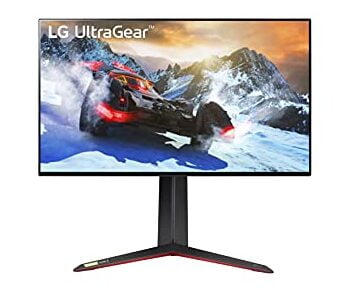
True Score
82834Experts
87903Customers
Absolutely Fresh
 SAVE $423$899.99$476.99
SAVE $423$899.99$476.99Snapshot
Reasons to Buy
- 4K resolution delivers great picture quality
- High peak brightness level
- Great color accuracy
- HDMI 2.1 ports for connectivity to modern consoles
- Support for HDR content
Reasons to Avoid
- Low contrast
- Poor reflection handling
- So-so ergonomics
Specifications

Available Inputs 3.5mm, DisplayPort, HDMI, USB 
Bluelight Filter n/a 
Built-In Speakers No 
Built-In Webcam No 
Curved Screen No Display Type IPS 
Flicker Free Yes HDMI Inputs 2 HDR Format HDR10, HDR600 High Dynamic Range (HDR) Yes Max Resolution 3840 x 2160 (4k) 
Panel Type IPS Refresh Rate 144 Hz 
Response Time 1 ms 
Rotating Screen Yes Screen size 27″ 
Sync Technology AMD FreeSync, AMD FreeSync Premium Pro, G-Sync All Specs
Test Results
Brightness (nits) 410 Contrast Ratio (as ratio x:1) 1,194 Color Gamut/Accuracy % (DCI P3 xy) 97 Color Gamut/Accuracy % (DCI P3 uv) 0 Color Gamut % (sRGB Coverage xy) 100 Color Gamut % (Adobe RGB Coverage xy) 88 All Retailers
- $476.99$900Save $423
Availability
In StockFree Shipping
Yes - $496.99$897Save $400
Availability
In StockFree Shipping
- $896.99$937Save $40
Availability
In StockFree Shipping
No - $899.99
Availability
In StockFree Shipping
Yes
Our Verdict
If you want to enjoy 4K gaming on your PS5, the LG 27GP950-B offers up to 4K fidelity with a price to match. Its 4.2 ms input lag makes it one of the most responsive monitors on our list, and the 4.4 ms response time helps reduce motion blur and keep the action on the screen clear. Although its 144 Hz refresh rate might not be the highest, it’s well-suited for PS5 gaming, ensuring smooth, tear-free play thanks to G-Sync and FreeSync support.
The LG 27GP950-B also offers excellent visual performance, boasting a market-leading 410 nits brightness that performs well in brightly lit environments. For HDR content enthusiasts, its 96.8% DCI P3 color gamut coverage offers true-to-life colors, while 100% sRGB coverage ensures that games look vibrant and rich, maximizing the PS5’s capabilities.
This monitor’s strengths go beyond gaming; it provides high-quality visuals for a wide range of multimedia purposes. Whether you’re streaming in high definition, editing photos, or watching films, the LG 27GP950-B’s superior color accuracy and range produce exceptionally clear and vivid images.
While the price of the LG 27GP950-B keeps it from being worth considering if you’ve got a budget to worry about, it is absolutely worth the investment if you’ve got the cash to spare. Offering rapid response times, exceptional input lag, and remarkable visual quality, the LG 27GP950-B is a fantastic match for the PS5, allowing you to fully enjoy responsive, richly detailed 4K gaming.

Best Overall

Runner Up

Best Value

Best Budget

Best Mid-Range

Premium Pick
Alienware AW2723DF
The Alienware AW2723DF balances high performance with responsive gameplay. Despite its price, its 8.6 ms input lag and 240 Hz refresh rate make it great for gaming and multimedia.
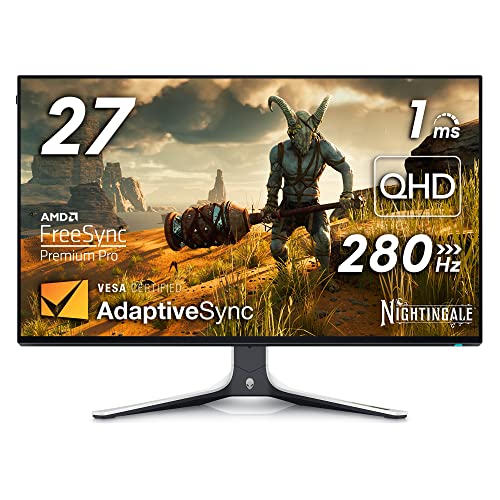
True Score
78804Experts
81293Customers
Mixed Reviews
 SAVE $200$649.99$449.99
SAVE $200$649.99$449.99Snapshot
Reasons to Buy
- Superb image quality
- Low input lag
- High native refresh rate
Reasons to Avoid
- Mediocre contrast ratio
- Adequate response time
- No HDMI 2.1
Specifications

Available Inputs 3.5mm, DisplayPort, HDMI, USB 
Bluelight Filter Yes 
Built-In Speakers No 
Built-In Webcam No 
Curved Screen No Display Type IPS 
Flicker Free Yes HDMI Inputs 2 HDR Format HDR10, HDR600 High Dynamic Range (HDR) Yes Max Resolution 2560 x 1440 
Panel Type IPS Refresh Rate 240 Hz 
Response Time 1 ms 
Rotating Screen Yes Screen size 27″ 
Sync Technology AMD FreeSync Premium Pro, G-Sync All Specs
Test Results
Brightness (nits) 403 Contrast Ratio (as ratio, x:1) 1,015 Color Gamut/Accuracy % (DCI P3 xy) 93 Color Gamut/Accuracy % (DCI P3 uv) 0 Color Gamut % (Adobe RGB Coverage xy) 90 Color Gamut % (sRGB Coverage xy) 100 All Retailers
- $449.99$650Save $200
Availability
In StockFree Shipping
Yes - $618.99$705Save $86
Availability
In StockFree Shipping
No
Our Verdict
The Alienware AW2723DF is a solid performer for PS5 gaming with all-around excellent performance. It features an 8.6 ms input lag and a 4.6 ms response time to minimize motion blur and maximize reaction speed, which is essential for competitive play. The 240 Hz refresh rate ensures exceptionally smooth action in dynamic games, with G-Sync and FreeSync support to prevent screen tearing.
A flicker-free panel and blue light filter reduce eye strain, enhancing this monitor’s appeal for lengthy gaming sessions and work. Its superior specs also make it ideal for watching movies and TV shows, bringing scenes to life with vivid colors and sharp contrast. Eye-care features add value as a productivity tool.
The monitor’s 402.8 nits brightness and 99.6% sRGB coverage provide excellent visual quality, improving visibility in well-lit environments and delivering accurate colors that will make games pop. However, its reflectivity rate of 7.6% limits how much ambient light the monitor can actually handle; if you have sources of direct light (or sunlight) that might hit the screen, glare could become an issue.
The AW2723DF offers comprehensive performance for both gaming and multimedia and is reasonably priced for its features. While it’s still an expensive monitor, its low input lag, excellent responsiveness, and fantastic brightness make it a worthy investment for PS5 users seeking a seamless gaming and streaming experience.
Which Criteria Matters for Testing Monitors for PS5?
By focusing on these criteria (2 required, 2 nice to have), anyone can quickly and easily compare these computer monitors and how they’ll perform. This helps you make an informed decision and purchase the best PS5 gaming monitor.
| CRITERIA | RANGE | REQUIRED | DEFINITION |
|---|---|---|---|
| Contrast Ratio | >1000:1 | Yes | The difference in brightness between the whites (lit sections) and blacks (dim or unlit sections) of a monitor panel. |
| Input Lag | < 15 ms | Yes | The time it takes for the monitor to register inputs from the user and process them as action. |
| Color Gamut (DCI P3 xy) | > 90% | No (Nice to have) | How much of the DCI P3 xy color gamut is covered by the monitor, which helps indicate color accuracy for HDR content, which includes certain movies. |
| Response Time | < 13 ms | No (Nice to have) | The time it takes for a pixel to change from one color to another. |
Our Trusted Data Sources
We looked at 110+ computer monitor reviewers and found that 33 are trustworthy (60%+ Trust Rating). The three we have listed below are our most trusted for computer monitors.
- Samuel Breton – Rtings, MuckRack
- Chris Eberle – Tom’s Hardware, LinkedIn
- Tony Hoffman – PC Mag, MuckRack
Interested in a comprehensive analysis of our data sources? We’ve got you covered. Below, you’ll find a detailed list of every computer monitor review website we’ve identified, organized by their respective Trust Ratings from highest to lowest. But we didn’t stop there. We’ve meticulously reviewed each publication and verified the data by checking whether the authors have bio links to MuckRack or LinkedIn. We’re committed to not only checking the facts but ensuring their veracity.
Computer Monitor Test Data & Results
1. Contrast Ratio (as ratio, x:1) Test Results
Contrast Ratio
> 1000:1
Acceptable range of performance
Definition: How bright the monitor will get, usually under specific testing conditions, like 10% windows (which means 10% of the screen is a white box.)
Units of Measurement: Ratio
Tools to Measure: Luminance meter or photometer or colorimeter
Why It’s Important:
Contrast ratio is how dynamic images are given detail and dramatic effect, with very dark areas appearing truly dark, while bright areas are bright and pop.
Contrast ratio is responsible for making images appear “dynamic” and “dramatic.” By having a good contrast ratio, a monitor is able to recreate dramatic differences between light and dark spots in scenes, images and games accurately.
At a minimum, we recommend a contrast ratio of 1000:1, as this will do a good enough job at allow for detail in dark scenes and images. If contrast ratio gets too low, the picture quality suffers, and the monitor performs worse across the board, no matter the lighting condition. By getting a monitor with a sufficiently high contrast ratio, you can ensure the picture quality doesn’t suffer, and dramatic scenes with stark shifts in lighting, whether they be in games or videos, are created as accurately as possible.
Contrast Ratio (higher is better)
2. Input Lag (ms) Test Results
Input Lag (ms)
< 15 ms
Acceptable range of performance
Definition: The amount of time it takes for a monitor to register an input from the user and display it.
Units of Measurement: Milliseconds (ms)
Tools to Measure: Input Lag Meter
Why It’s Important:
Input lag introduces artificial delay when gaming, which creates a mismatch between your reactions and on-screen action and creates frustration.
Input lag is more of a concern when it comes to gaming, but if you plan on using a monitor for a bit of gaming when you aren’t focused on productivity, editing or other tasks, lower values help improve responsiveness. High input lag means your actions take longer to register on the monitor, effectively introducing an artificial delay to your reactions.
It’s for this reason that we generally recommend an input lag under 15 ms. This ensures the delay that’s introduced has minimal impact on your reactions to what’s happening on screen. It’s important to note that a high input lag won’t have any real effect on anything that isn’t gaming, so it can be safely ignored if you don’t plan on gaming on your monitor.
Input Lag (in ms; lower is better)
3. Color Gamut/Accuracy % (DCI P3 xy) Test Results
Color gamut is responsible for making a monitor produce accurate colors when displaying a variety of content. The DCI P3 xy gamut is considered a “standard” gamut of sorts, and is used to help color grade films. Most HDR content will use this gamut at the very least (though other gamut exist) and it’s a commonly used gamut for films.
When it comes to a computer monitor, having a panel that covers at least 90% of the DCI P3 gamut means it’ll output accurate colors when watching HDR content and movies that use the gamut. If a monitor doesn’t cover enough of the gamut, it causes color inaccuracies and shifts the image quality. If you care about maintaining accuracy in the movies you watch so they look the way they were intended, this gamut needs to be properly covered.
Color Gamut/Accuracy % (DCI P3 xy)
> 90%
Acceptable range of performance
Definition: The amount of the DCI P3 xy gamut that the monitor covers.
Units of Measurement: %
Tools to Measure: Colorimeter
Why It’s Important:
Color gamut coverage is important for ensuring that a monitor is able to accurately output colors. The DCI P3 xy gamut is responsible for making movies and HDR content look the way they were intended.
Color Gamut P3 XY (in %; higher is better)
4. Response Time (ms) Test Results
Response time measures how long it takes pixels to change from one color to another, often gray to gray. Low response times means the monitor is able to keep up with constant shifts in colors, and helps prevent motion blur from being introduced whatever you’re watching.
We generally recommend a response time that is 13 ms or less, as this will keep motion blur to a minimum, but if you don’t watch a lot of very high intensity videos or play fast-paced games, response time isn’t going to matter much. It’s important to note that monitors will often advertise a 1ms or 2ms or 5ms response time, to name a few, but response time tests measure full color to color shifts, as well as overshoots, which produces different times than what the monitor often claims on the box. This is why response time is a listed spec, but also a testable criterion.
Response Time (ms)
< 13 ms
Acceptable range of performance
Definition: The amount of time it takes for pixels on a monitor to shift from one color to another.
Units of Measurement: Milliseconds (ms)
Tools to Measure: Response time tool, camera
Why It’s Important:
Faster response times keep the screen from becoming muddied and blurred when fast-paced action scenes in movies or games start.
Response Time (in ms; lower is better)
Best Monitors for PS5: Mistakes To Avoid
- Ignoring HDMI 2.1 Support: The PS5 supports HDMI 2.1, which enables features like 4K resolution at 120Hz, Variable Refresh Rate (VRR), and Auto Low Latency Mode (ALLM). Ensure the monitor you choose has at least one HDMI 2.1 port to take full advantage of the PS5’s capabilities. When deciding between HDMI vs DVI for gaming, it’s important to note that HDMI offers higher resolutions and refresh rates, making it the preferred choice for gaming on modern consoles like the PS5.
- Not Considering Panel Type: Different panel types (e.g., TN, IPS, VA) offer different color accuracy, viewing angles, and response times. Choose a panel type that aligns with your gaming and other multimedia activities preferences. Also, take into consideration the screen size. A 24-inch monitor can be an excellent choice for compact setups, offering a good balance between size and space efficiency, with the right panel type enhancing the overall visual experience.
- Forgetting About Audio: While most monitors have built-in speakers, they may not offer the best audio quality. Consider investing in external speakers or a gaming headset for a more immersive audio experience.
- Ignoring HDR Support: The PS5 offers HDR (High Dynamic Range) gaming for enhanced contrast and color depth. Look for monitors with HDR support to fully appreciate the visual fidelity of HDR-enabled games. For instance, the HP U28 4k HDR monitor review showcases its ability to deliver vivid colors and decent contrast to complement the PS5’s HDR gaming capabilities.
The Best Monitors for PS5 Tests Compared
Product |
True Score
|
Brightness
|
Contrast Ratio
|
Color Gamut (DCI P3)
|
Color Gamut (sRGB)
|
Input Lag (ms)
|
Response Time (ms)
|
Reflections % | |
|---|---|---|---|---|---|---|---|---|---|
| 87 |
|
|
|
|
|
|
| $741.00 |
| 85 |
|
|
|
|
|
|
| $199.99 $300 $100 |
| 84 |
|
|
|
|
|
|
| $999.99 |
| 82 |
|
|
|
|
|
|
| $476.99 $900 $423 |
| 78 |
|
|
|
|
|
|
| $449.99 $650 $200 |

